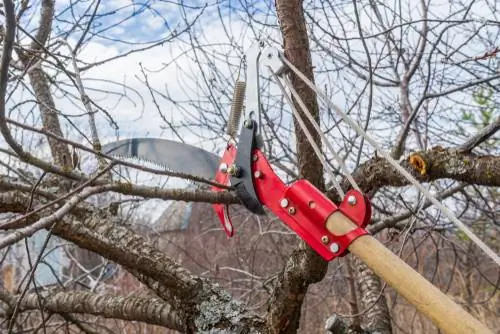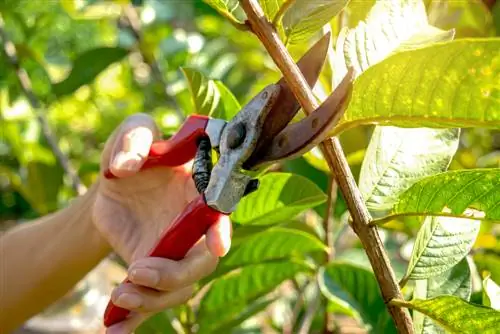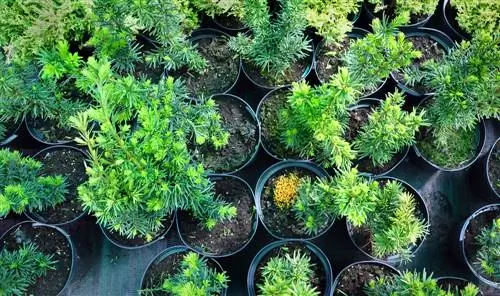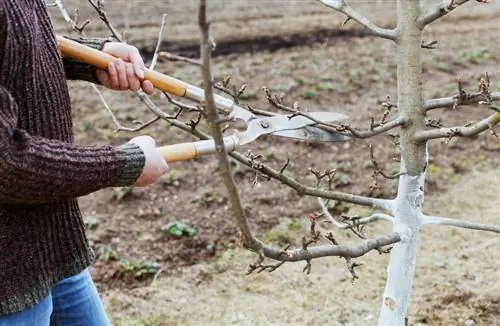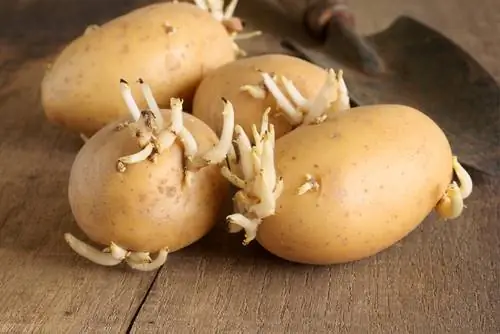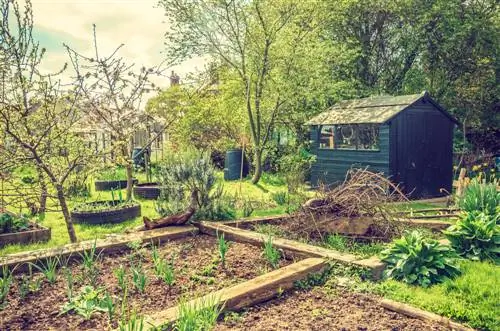- Author admin [email protected].
- Public 2023-12-24 06:09.
- Last modified 2025-06-01 06:02.
The culinary enjoyment of freshly picked cherries is reserved for gardeners who own a cherry tree. Sweet cherries grow into impressive trees, are sensitive to cutting and still produce juicy fruit even on old wood. This requires systematic pruning care, from training through maintenance to rejuvenation. In this tutorial you can read all the cutting instructions. How to prune your cherry tree correctly.
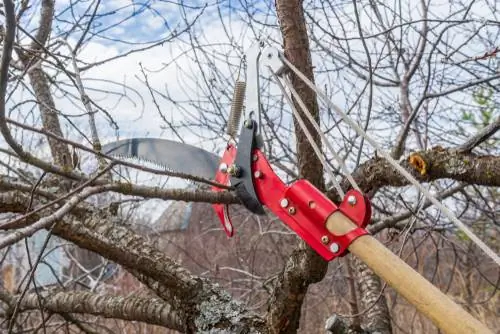
How to trim a cherry tree?
It is best to prune the cherry tree after the harvest in summer. Start with the large branches. This is followed by the smaller twigs and branches in late winter. This gives sweet cherries a compact but loose crown. As many one- or three-year-old fruit shoots as possible develop on this.
Cutting types and dates
The sweet cherry occupies aspecial positionamong all fruit trees. Flowers appear on short, annual and biennial shoots. Furthermore, older shoots also bear valuable fruit wood, richly decorated with numerous flower buds, which is known in technical jargon as bouquet shoots. Cherry trees trained with awell-lit round crown are covered with fruit wood along their leading branches deep into the interior of the crown. This unique growth behavior is accompanied by a pronounced sensitivity to cutting. Apart from the training phase, a cherry tree should be pruned at intervals of 3 or 4 years. The following overview summarizes all types of cuts with the best dates:
| Cut style | Goal/Occasion | best date |
|---|---|---|
| Educational Cut | Building a light-flooded round crown | February/March in the 1st to 6th or 8th year |
| Conservation cut | Clear out dead wood, promote fruit wood | every 3-4 years in the summer after the harvest |
| Rejuvenation cut | revitalizing a neglected cherry tree | in late winter |
Training pruning forms a productive crown
In the first few years of pruning on the cherry tree, the aim is to create a perfectly shaped crown. On majestic sweet cherries, the crown development takes place over six to eight years. A space-saving spindle tree benefits from careful crown structure in the first three to four years of existence. This is an exemplary way to raise a sweet cherry:
- The best time is in early spring, before budding begins
- Build a crown framework with a dominant central shoot and 3 leading branches at an ideal angle of 90 to 120°
- Remove steeply upward competitors to the central shoot or spread them out in an inclined position
- Tie branches that are too flat up to an ideal angle of 45° to 60°
- Side scaffold shoots in the sap balance are kept at the same height by cutting back to tip buds
Before you cut away a side shoot that is pointing steeply upwards, check itssuitability for fruiting wood A green shoot is still flexible. If it is in a favorable position on the crown framework, tie the young branch in the advantageous sloping position. When spread out at an angle of around 60°, the sap pressure is reduced, growth calms down and the first flower buds flourish. To spread it out, you can fix the shoot to its leading branch with a string. You can easily direct the growth on the spindle tree into the ideal position using clothespins. Specialist retailers also have special wooden spreaders available.
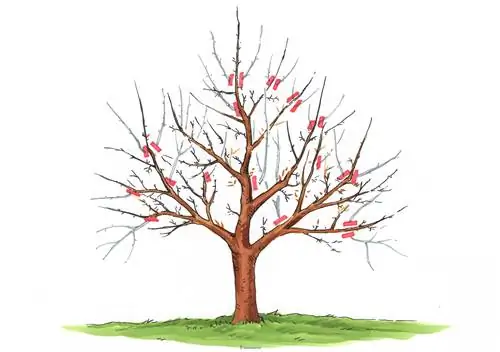
In the first 4 to 8 years, you will grow a productive crown on the cherry tree. The perfect framework consists of a central shoot and three evenly distributed leading branches. Starting from the tip, the middle forms an angle of 120° with the side branches.
Excursus
Pruning time influences growth strength
An old farmer's saying is still valid today: “If you want to see a cherry tree bear fruit, cut it in summer. If you want to see your cherry tree grow, cut it in winter.” Anyone who has not yet been able to convince themselves of the evidence in practice will receive confirmation from a botanical-scientific point of view. In early spring, the tree releases the majority of its reserve substances, which are transported under high pressure towards the top buds. This results in a strong growth spurt. As the season progresses, the sap pressure decreases and growth is reduced to a minimum. It follows that if you want to stimulate growth, cut when the sap pressure is strongest. To calm growth and increase fertility, summer is the best time to prune.
Cut at 4-year intervals - instructions for maintenance cutting
At the beginning of the yield phase, pruning care on the cherry tree transitions from training to maintenance. Sweet cherries bloom and fruit on annual, unbranched shoots that are shorter than 10 centimeters. As shown in the figure below, there are flower buds at the base of the shoot. Two-year-old, slightly branched shoots are richly decorated with flower buds along their entire length. Three-year-old and older branches also boast numerous flower buds in spring. In combination with a pronounced sensitivity to pruning, a maintenance pruning every three to four years is part of the care program for a cherry tree. This is how you do the maintenance pruning on sweet cherries correctly:
- The best time is after the harvest in summer
- Remove crossing and dead branches growing inside the crown
- Dropping shoots that are more than 5 cm thick lead to a side shoot that is further inward
- Thin out old, aging branches to 10 to 20 cm short cones
- Prune previous year's unbranched long shoots to 10 to 15 cm
- Make the cut just above an outward-facing, pointed leaf bud or leaf

Short, whorled shoots with numerous flower buds are spared from cutting. The so-called bouquet shoots are extremely fertile and will give you a rich fruit display next year. After a professional pruning, the crown of your cherry tree appears empty. This is not an indication of a wrong approach. By next summer, the crown structure will be loose, flooded with light and bearing a large number of juicy, sweet cherries.
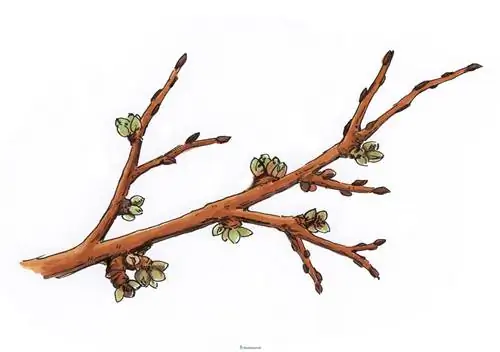
The focus of the conservation cut is the valuable fruit wood. A cherry tree should not be cut where there are rounded flower buds. Thin out dead wood, steep and awkwardly positioned shoots with pointed leaf buds.
Deriving is better than shortening
It is characteristic of sweet cherries that they react to the loss of their shoot tips with unfavorable whorls at a young age. Thick tufts sprout from sleeping eyes, shading valuable fruit wood and flower buds. You can prevent the undesirable reaction by preferring thederivation cutto a simple pruningon young trees. Here, a leading branch is redirected to a subordinate side shoot to obtain a crown flooded with light. This is how you make the perfect drainage cut in the cherry tree:
- Don't just cut back an overly long cherry tree branch
- Instead, choose a young, outward-facing side shoot further inward
- Cut at the fork of old and young branches
- Place the scissors a few millimeters into the old wood
- Result: young side shoot replaces the worn fruit branch without whorl formation
With a derivation you can also take action againstZwiesel. This is what gardeners callV-shaped forks, which in the long run make the cherry tree unstable. Look out for the double shoots on young sweet cherries so that you can remove one of them in good time by pointing to the better positioned shoot. If a Zwiesel thrives as a vertical competitor to the central shoot, it should be removed completely.
Tip
If a cherry tree bears morello cherries and similarly juicy, sour fruits, different pruning rules apply. Here the most productive fruit wood is found on long, previous year's shoots, so vigorous pruning every year makes sense. For this reason, a separate tutorial is dedicated to cutting sour cherries.
Rejuvenate an old cherry tree in stages - this is how it works
Have you prescribed a rejuvenation treatment for an old cherry tree that has been left uncut for many years? Then please proceed step by step. Instead of thinning out the aging crown in one go, spread the measure over two to three years. The sensitivity to cutting means that you do not saw off thick, dead shoots on Astring. It is gentler to cut on tenons. The following procedure has proven itself well in gardening practice to revitalize an old sweet cherry:
- The best time is over a period of 2 to 3 years, always in late winter
- Additionally blend in summer in the second and third year
- Important: Avoid cuts larger than 10 centimeters in diameter
- At the beginning, cut out dead wood, inwards, vertical or cross-growing branches
- Overhanging leading branches slim down to a young side shoot close to the trunk
The transition from rejuvenation to maintenance cut is fluid. If your cherry tree responds well to the first stage, carry out an initial maintenance measure in the rejuvenated crown area in the summer after the harvest. If all regions of the crown have rejuvenated after three years at the latest, pruning care is reduced to a summer maintenance cut every three to four years, as this tutorial explains.
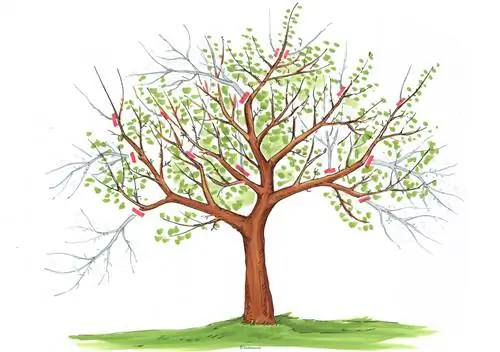
To rejuvenate an old cherry tree crown, start by cutting off dead wood to 10 to 20 cm long cones. The cones on Astring are only removed after 1 to 2 years. Overhanging scaffolding shoots can be slimmed down to side shoots positioned on the inside.
Sawing thick branches onto tenons in stages
If you find yourself forced to remove a branch that is more than 10 centimeters thick from the crown, follow these steps:
- Saw the branch at a distance of 30 cm from the trunkfrom below to the middle
- Move the saw 10 cm to the right or left
- Stabilize the branch with one hand andsaw from above until it breaks off
- Saw the stump to a tenon with a length of 10 cm
You can remove the remaining cone after one to two years. As a rule, vertical and flat young shoots emerge from a cone. Leave one or two of the most promising, horizontal candidates standing. There are good prospects that valuable fruit wood will develop from it. All remaining young shoots and the remains of the dried cone are removed.
Background
Perform rejuvenation pruning in winter
The best time for rejuvenation pruning on the cherry tree is controversially discussed among experts. Numerous sources recommend an appointment in summer because the radical pruning is more tolerable for a sweet cherry. Responsible orchardists ignore the recommendation and prune in late winter out of respect for nature and the Federal Nature Conservation Act. Birds nest in the dense canopy of mighty cherry trees in summer. Inhabited nests could fall victim to a rejuvenation cut. Paragraph 39 of the Federal Nature Conservation Act emphasizes the concerns and prohibits cutting measures between March 1st and September 30th that go beyond a maintenance cut.
Tips on tools and accessories
The key to success in cherry tree pruning is a combination of the right approach and appropriate equipment. The following basic equipment is mandatory in order to blend a sweet cherry safely and professionally:
- One-handed pruning shears for branches up to 2 cm in diameter, optionally as bypass or anvil shears
- Two-handed pruning shears with telescopic handle for branches 3 to 5 cm thick
- Folding saw with Japanese teeth or hacksaw for thick shoots from 4 to 5 cm in diameter
- Knife for smoothing cuts
- Stable ladder with two legs
- Gloves, safety glasses
Modern pruning shears with telescopic handles enable cuts up to a dizzying height of 4 meters, making daring climbs in the mighty cherry trees unnecessary. With an innovative cutting giraffe you can cut branches up to 6 meters high precisely and safely. When buying cutting tools and accessories, make sure they are of high quality. This makes pruning work easier, leaves smooth cuts and optimizes safety for gardeners and cherry trees alike.
Frequently asked questions
For cost reasons, I decided to buy two cherry trees bare root. Should I subject the young trees to pruning?
On bare-root trees, planting pruning guarantees a good start and paves the way for the best possible upbringing. For the crown framework, choose the strongest shoot as a trunk extension. Three to four leading branches should be evenly distributed around the central shoot, which are at an ideal angle of 45° to 60° to the central shoot. Branches that are too steep are spread apart. Shoots that are too flat are tied up. Cut the leading branches back by a third. After cutting, the tip buds of the leading branches should be at the same height, in the so-called juice level. The central shoot towers over the leading shoots, so that an imaginary triangle is formed with an angular position of 90 to 120°.
I would like to plant a cherry tree under whose crown I can still maneuver the lawnmower. How do the trunk heights that I can purchase in tree nurseries differ?
For young cherry trees, nurseries differentiate between bush trees or quarter trunks with 40 to 60 cm. Half-trunks reach a height of 120 cm. Standard trunks have a height of 200 cm. This trunk height usually does not change. An exception applies if the gardener cuts the crown and branches the trunk. Bush trees just make it possible to mow the tree disc with a hand mower. Cutting the lawn with a ride-on mower under a half-trunk is worth a try. There are no difficulties in terms of freedom of movement under a standard tree.
Our cherry tree was planted 2 years ago. When would be the best time to trim the tree?
The sweet cherry fruits on biennial or perennial wood. An adult cherry tree should primarily be pruned in the summer, immediately after the harvest. This cutting time promotes the formation of fruit buds. For a young tree that is only two years old, however, we recommend pruning in spring, parallel to the start of budding. The first short shoots with flowers appear in the third year at the earliest. From this point on, if necessary, subject the cherry tree to summer pruning to calm growth and encourage fruiting.
A year ago we planted a sweet cherry as a bush tree, which bore a sparse 7 flowers this year. What can I do to increase the number of flowers?
The number of flowers is completely normal and even positive. Young cherry trees concentrate on root formation and growth in their first few years. Please be patient a little longer. Over the next few years, more and more flowers will flourish, parallel to the larger growth. A supplementary nutrient supply from the second year onwards in the form of compost and horn shavings or an organic fruit tree fertilizer is advantageous.
I would like to plant two to three cherry trees in the garden. From which year can I expect the first harvest?
A cherry tree with a medium to weakly growing rootstock bears its first fruit on average after 3 to 6 years. A sunny location and competent training with a light-flooded crown and horizontal fruiting wood have a significant influence on the beginning of the yield phase.
There are three cherry trees in my garden that my predecessor planted far too close together four years ago. The trunk height is 100 to 120 centimeters. Is it possible to transplant sweet cherries this large? If so, what should you pay attention to?
It is still possible to transplant cherry trees within the first five years of existence. The best time is in autumn after the leaves fall. Cut off the root slice with a sharp spade in as large a radius as possible. The more roots move with the tree to the new location, the more promising the procedure is. Since a large proportion of root mass is lost as a result of clearing, the cherry trees should be pruned accordingly. Adequate water and nutrient supply is important so that transplanted trees can root quickly and strongly.
The 3 most common cutting mistakes
If a cherry tree is characterized by a dense network of sterile steep shoots, massive growth of dense shoot whorls and large, non-healing cuts, the gardener has made typical pruning mistakes. The following overview draws attention to the three most common mistakes in pruning sweet cherries and gives tips for skillful prevention:
| Cutting errors | malicious image | Prevention |
|---|---|---|
| Steep shoots not thinned out or corrected | Crown with numerous, barren branches | Cut off steep shoots onto cones, spread them or tie them up |
| Excessive branches cut off somewhere | massive growth of dense shoot whorls at the tips | Reduce shoots that are too long instead of simply shortening them |
| thick branches not cut to cones | non-healing cuts, spread of wood rot | saw thick branches in stages and onto tenons |
Tip
If a cherry tree does not bear fruit, the problem is usually due to the lack of a pollinator. With a few exceptions, sweet cherries rely on a second variety in close proximity. Since not all cherry varieties cross-pollinate, please ask your local tree nursery when purchasing which combinations are suitable.

